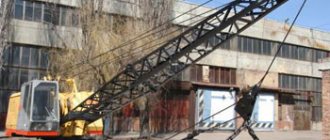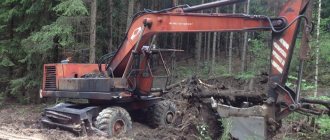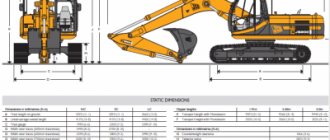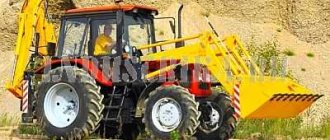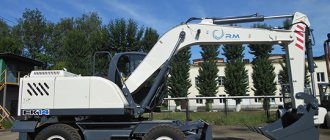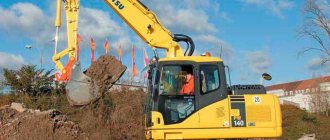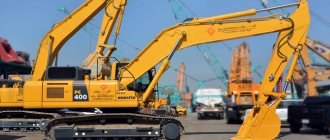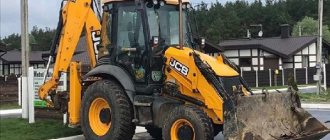Excavator EO-4124
The universal crawler excavator EO-4124 is currently a fairly popular piece of equipment.
The first industrial batch of EO-4124 excavators was manufactured at the Kovrov Excavator Plant in 1978. Then it was the first Soviet full-rotary excavator on a tracked chassis. Before this, the full-rotation layout had not been used, despite the fact that it is a very advantageous design solution. In the design of the EO-4124 excavator, many things were done for the first time. Thus, the pressure of the working fluid in the hydraulic circuit of the drive of the working bodies was ensured at the level of 250 kg/cm, which was a record figure at that time.
Due to the fact that the EO-4124 excavator is currently in active use, spare parts for it are still being produced. Also, its design has a minimum number of parts (without compromising functionality), which makes it very repairable. Very high unification is maintained with a lot of brands of similar foreign excavators (in terms of hydraulics). This makes it easier to find the parts you need.
Video
The excavator is a classic representative of the construction equipment segment of the 70-80s. The model can safely be attributed to the ancestors of full-rotary earth-moving machines, since it was on it that the principle of hydraulic rotation of equipment was first applied. The key point was to increase the pressure in the hydraulic system to 250 kgf/sq.cm, which made it possible to maximize the power and productivity of the equipment.
Another advantage of the excavator was ease of maintenance, due to ease of access to any components and mechanisms of the excavator. This quality made the equipment cheaper to operate and speeded up the repair process.
Parts of the power plant, body and equipment of the EO-4121 were made of high-strength metal, which protected against corrosion and prevented rapid destruction. A clear indication of the incredible durability of the model is that some pieces of equipment are still in operation today.
The optimal location of the center of gravity and the presence of counterweights made it possible to achieve increased stability during operation.
EO-4121 was produced with replaceable working equipment (backhoe or front shovel, loader, grab) and buckets with a capacity of 0.65 to 1.5 cubic meters. The excavator was intended to work in areas with a temperate climate and temperature conditions from -40 to +40 degrees (in the tropical version - up to +55 degrees).
The release of this model was due to significant economic efficiency in comparison with equipment of the E-625B category with a mechanical drive.
Excavator EO-4124. Main technical characteristics.
Engine power 95 - 130 hp. on various modifications (average - 100 kW).
Operating weight - 22 -25 tons depending on attachments.
Work on all categories of soil (developed force on the bucket teeth is 140,000 N).
The maximum depth of soil sampling is 5 meters.
The maximum loading height is 5 meters.
Bucket volume 0.65 – 1.3 m (replaceable buckets and other attachments depending on the type of soil).
The caterpillar drive is a separate hydraulic motor for each caterpillar.
Travel speed - 2.8 km/h.
Overcome ascent/descent - 22 degrees.
The starter is a two-stroke petrol carburetor.
The diesel engine of the EO-4124 excavator is still produced A-01M by AltaiHydroMash LLC, so there will be no problems with spare parts. It drives two hydraulic pumps with variable displacement . Both pumps are installed in the same housing and driven through a gearbox. characteristics of the EO-4124 excavator :
Power – 90 – 130 hp. depending on the operating mode.
Number of cylinders - 6.
Number of valves - 12.
Fuel consumption - 180 g/hp.
Compression ratio - 16.
The EO-4124 excavator motor has many design features. So the injection pump is of the spool type, not the plunger type. Nozzles - with multi-hole sprayer. The air filter is a centrifugal cyclone type. The starter is filled with gasoline and 1/15th of engine oil. To start a gasoline starter with a power of 10 hp. An electric starter is used.
The tracked trolley of the EO-4124 excavator is equipped with tracks made of cast tracks with lantern gearing. Now this solution is used quite rarely, but it provides excellent reliability and wear resistance of excavator tracks . As a rule, the service life of tracks increases two to three times compared to conventional tracks.
In most cases, EO-4124 excavator is operated with a backhoe bucket with a capacity of 0.6 m. This allows the development of soils that have not previously been loosened. About 50 types of various attachments can be installed on the hydraulic boom hydraulic hammers of various capacities, a loading bucket , a bucket for loose soil with a volume of 1.3 m and more.
Since the EO-4124 excavator was the first fully rotating excavator, the designers were faced with the task of balancing it on the platform. At the same time, it was necessary to create a significant advantage in the rear part, which would allow increasing the force developed on the bucket. For this reason, the cabin and engine EO-4124 excavator are separated by 2 meters, which now looks unusual. Also, two hood doors are also located in the rear, and not on the side. An additional counterweight is also installed there.
Device
This model is a crawler-mounted vehicle that is capable of performing numerous operations.
Important components of an excavator include a caterpillar track, a metal platform with the ability to rotate 360 degrees, a driver's cabin with a control panel, working equipment, an engine, a hydraulic system and electric sensors.
The running gear of the EO 4121 excavator is made in such a way that each caterpillar can be driven separately using an individual hydraulic motor. The belt tension is carried out by a hydraulic cylinder.
1 – ladle; 2 – bucket hydraulic cylinder; 3 – handle; 4 – hydraulic cylinder of the handle; 5 – insert; 6 – boom hydraulic cylinder; 7 – boom; 8 – rotating platform; 9 – running crawler trolley
For the first time, the hydraulic system of this model tested a pressure of 250 kgf/cm2. The result was positive, since the boom force is sufficient to work with viscous soils and frozen ground. The moving platform of this universal excavator is mounted on a reinforced chassis frame. It is attached using a special roller mechanism that allows you to rotate the entire structure. There is a mounted working element, a tank for fuel and working fluid, a driver's cabin, an engine and a turning mechanism. A counterweight is installed at the rear to provide stability when handling large loads.
Overall dimensions in transport position:
- Crawler undercarriage base, m 3.7
- Length of tracked undercarriage, m 4.56
- Clearance under the turntable, m 1.1
- Radius of rotation of the tail part of the platform, m 3.28
- Length in transport position, m 10.25
- Turntable width, m 3.0
- Height to cabin roof, m 3.0
- Track track, m 2.4
- Height in transport position, m 3.3
- Clearance under the running frame, m 0.46
- Caterpillar height, m 0.99
- Width of tracked undercarriage (with track width 600mm/), m 3.00
Work zone
Largest digging radius at parking level 9.3 m
Maximum kinematic digging depth 6.0 m
Maximum digging height 7.7 m
Maximum unloading height 5.15 m
Cabin
Since the EO-4124 was the very first model of a full-rotary excavator in the USSR, its designers were faced with the task of balancing it on a turntable. At the same time, it was necessary to create a significant advantage in the rear part - this would make it possible to significantly increase the force developed on the bucket. For these reasons, the cabin and engine of the EO-4121 excavator are separated by two meters, which in our opinion looks quite exotic. It can also be noted that the 2 hood doors are also located in the rear of the excavator, and not in the side. An additional counterweight is installed in the same place.
The cabin, from a modern point of view, is an ordinary “tin box”, reminiscent of a “birdhouse”, with the most minimal set of amenities for the driver. However, it is equipped with ventilation and heating, heat and noise insulation, a seat with a soft cushion, as well as a number of instrumentation and control levers. Light bulbs are provided for lighting and signaling.
In most cases, the EO-4124 excavator is operated with a backhoe bucket with a capacity of 0.6 m. This allows the development of soils that have not previously been loosened. About 50 types of various attachments can be installed on the hydraulic boom: hydraulic hammers of various capacities, a loading bucket, a bucket for loose soil with a volume of 1.3 m and more.
Replaceable work equipment
On EO-4121 excavators you can install rotary or fixed buckets. The rotary one significantly expands the scope of application of the excavator, since it can not only develop and load soil, but also plan the face. A feature of the working equipment of the grab for the EO-4121 excavator is the use of the base and head parts of the boom, the handle and the hydraulic cylinder of the reverse handle shovels. The grab bucket consists of two jaws and two rods.
Front and back shovel buckets with a capacity of 1 cubic meter are designed for developing soils up to the fourth category, and a bucket with a capacity of 0.65 cubic meters is designed for working with crushed rocks and loosened frozen soils. A loader bucket with a capacity of 1 cubic meter loads soils and materials with a volumetric mass of up to 2.2 tons per cubic meter, and a bucket with a capacity of one and a half cubic meters loads soils and other materials with a volumetric mass of up to 1.6 t/m3. To the permanent equipment of the EO- 4121" include a handle and one type of shovel. Replaceable equipment includes equipment that is installed specifically, depending on the type and nature of the work being performed at a given time. The list of replaceable equipment "EO-4121" is as follows: a backhoe with a handle of different lengths; profile bucket; straight shovel with bucket; gripping and pincer mechanism; loading forks; hydraulic hammer; ripper; hydraulic shears; magnetic plate; grab equipment.
Ladle
The fastening devices on the excavator boom are designed to work with rotary and fixed-type attachments of various sizes and configurations. Rotary shovels are more functional; they are used to load liquid and loose soils and to precisely clean the quarry walls.
The 0.65 m³ bucket is designed for working with hard or frozen rock. The removable teeth are made of hardened steel, resistant to abrasion, impact and pressure.
Shovels with a volume of 1 m³ are used when digging pits and trenches in medium-density soil. Products with an opening bottom are more productive. They are used in the construction of dams and dams, backfilling pits and ravines.
A 1.5 m³ bucket is used for loading bulk materials with low density. This can be construction and household waste, dry sand and various mixtures.
You can expand the capabilities of the equipment using a grab, a magnet, a hydraulic hammer, a ripper and a gripping device.
Excavators EO
EO excavators are part of municipal construction equipment. The machines are used not only in the countries of the former USSR, but also abroad. EO excavators are suitable for municipal construction work due to their high efficiency and versatility. Now the machines are used not only by state enterprises - they are in the public domain. The model range is also valued by owners of construction companies for cheap repairs of EO excavators and a large selection of replacement parts. Production continues today - two types of EO excavators are rolling off the assembly lines of the largest factories (the main supplier-manufacturer of EO excavators is Ural-MASH):
- Tracked vehicles;
- Wheeled vehicles (in limited quantities).
EO excavators: history of the model range
Universal machines were originally a modification of the T-30 tractor. In the early 60s, quick-detachable attachments were installed on its base. The modification was named E-201, it was intended for carrying out small-scale loading, unloading and earthworks. After some time, based on the MTZ-5 Belarus tractor models, an improved model from the E-201 appeared, which was called the E-221.
In 1974, the Borodyansky and Zlatoust plants, which produced excavators, began to produce large-scale mounted structures under the EO-2621V brand, which were installed on the new YuMZ-6KL chassis. From this moment the production of the EO model range begins. The first model was radically different from the tractor. Changes affected the cabin - the new layout made it possible to significantly expand the space inside and install a swivel operator's chair.
Since 1986, the Saransk plant began producing the EO-2621 V-2 model based on YuMZ-AKL. The machine mechanism received a new elbow, allowing excavation of soil to a depth of 4 meters, the angle of rotation of the bucket is 210 degrees. Starting in the late 90s, tracked models began to appear. Today, more than 12 enterprises throughout the CIS produce this equipment: the entire model range of EO excavators is still divided into tracked and wheeled vehicles.
Technical characteristics of EO Excavators
Excavators EO: wheeled
EO excavators, regardless of the model, can be equipped with both the main working equipment and a number of additional devices, which include: a hydraulic hammer, a grab, three types of loading forks, a bulldozer blade, a loading bucket with a volume of 0.5, a telescopic handle, drilling equipment, and a crane suspension instead of a bucket, a backhoe with a mixed axle.
Technical characteristics of EO Excavators differ in power, dimensions and bucket volume. The EO 2621 excavator has the following characteristics:
- Length – 7700 mm;
- Width – 2400 mm;
- Height – 3800 mm;
- Operating weight – 6300 kg;
- Engine power – 59.6 kW (81 horsepower).
- Maximum transport speed – 18 km/h;
- Nominal bucket capacity – 0.1-0.28 m3;
- Maximum digging depth – 3900 mm;
- The largest digging radius is 5200 mm.
The next in the wheeled line is the EO-33211A excavator, equipped with a transmission and a diesel engine. Due to the presence of the box, the excavator can move in two gears. The model is designed for large-scale work. EO-33211A has the following technical characteristics:
- Length – 9500 mm;
- Width – 2500 mm;
- Height – 3680 mm;
- Operating weight – 18000 kg;
- Engine power – 110 kW (150 horsepower).
- Maximum transport speed – 25 km/h;
- Nominal bucket capacity – 0.42-1.05 m3;
- Maximum digging depth – 5800 mm;
- The largest digging radius is 9200 mm.
The EO-3322 excavator has smaller dimensions, but there is almost no loss in carrying capacity:
- Length – 7550 mm;
- Width – 2500 mm;
- Height – 3700 mm;
- Operating weight – 14000 kg;
- Engine power – 75 kW (96 horsepower).
- Maximum transport speed – 19.68 km/h;
- Nominal bucket capacity – 0.65 m3;
- Maximum digging depth – 4900 mm;
- The largest digging radius is 6200 mm.
Next comes the EO-3322A modification - the EO-3323 wheeled excavator with reduced dimensions and a more economical engine:
- Length – 7550 mm;
- Width – 2500 mm;
- Height – 3700 mm;
- Operating weight – 14000 kg;
- Engine power – 55.2 kW (about 75 horsepower).
- Maximum transport speed – 19.4 km/h;
- Nominal bucket capacity – 0.5-0.8 m3;
- Maximum digging depth – 5400 mm;
- The largest digging radius is 8500 mm.
EO crawler excavators
The track line begins with model 3122, which received alternative propulsors:
- Length – 7700 mm;
- Width – 2650 mm;
- Height – 3500 mm;
- Operating weight – 14500 kg;
- Engine power – 53 kW (about 74 horsepower).
- Nominal bucket capacity – 0.5-0.63 m3;
- Maximum digging depth – 4400 mm;
- The largest digging radius is 8000 mm.
The second tracked model was the EO-3223 machine; the hydraulic drive of the excavator is similar to the EO-3122 excavator, since the hydraulic systems of the excavators are almost the same. The EO crawler excavator has the following parameters:
- Length – 8700 mm;
- Width – 3200 mm;
- Height – 3100 mm;
- Operating weight – 14120 kg;
- Engine power – 74 kW (about 100 horsepower);
- Maximum transport speed – 19.4 km/h;
- Nominal bucket capacity – 0.32-0.8 m3;
- Maximum digging depth – 6500 mm;
- The largest digging radius is 9450 mm.
The new generation of crawler excavators begins with the EO-4124, for which a ripper tooth was added. There are modifications - EO-4124a and EO-41245a-07, the original model received the following characteristics:
- Length – 10500 mm;
- Width – 3170 mm;
- Height – 4000 mm;
- Operating weight – 32000 kg;
- Engine power – 132 kW (180 horsepower);
- Maximum transport speed – 3.5 km/h;
- Nominal bucket capacity – 1.45 m3;
- Maximum digging depth – 6200 mm;
- The largest digging radius is 9600 mm.
Excavator EO 4124 technical characteristics
Technical characteristics of the EO-4124HL excavator
straight shovel
Backhoe
Ripper tooth
Hydraulic hammer SP-62HL with a monoblock boom
The technical performance of an excavator equipped with a backhoe when mining frozen sandstone with layers of frozen clay with a strength of up to C = 50 - 75 with a 90° rotation and unloading into a dump was 184.2 m3/h, and that of an excavator equipped with a straight shovel was 173.3 m3/h. High technical and economic performance indicators of the prototype excavator were obtained over the entire testing period.
Technical and economic indicators of the operation of the EO-4124HL excavator with a backhoe bucket with a capacity of 1 m3
When testing the machine, the tractor-type caterpillar drive with lugs and automatically controlled disc brakes with a high total traction force of 150 kN ensured the maneuverability and maneuverability of the excavator in off-road conditions and difficult terrain with overcoming slopes of up to 26°. Electric heating and ventilation system of the driver's cabin in 45-50 minutes. operation of the excavator ensured a temperature at seat level of 14°C, a temperature difference across the cabin height of no more than 6°C, and an air exchange in the cabin of 40 m3/h. The diesel heating system worked satisfactorily. Warming up of the diesel engine, starting engine and batteries was carried out in 5 - 9 minutes. at air temperatures down to minus 36°C and in 17 - 22 minutes. at minus 40 - 47°C. At air temperatures below minus 36°C, additional batteries were used to operate the preheater. Tests have shown that the presence of a pre-heater, devices for heating batteries and heating the working fluid, a powerful cabin heater, a heat-and-noise-insulated sealed cabin with an additional seat, a convenient layout of the machine, and folding ladders made it possible to create comfortable working conditions for the operator and maintenance of the excavator. The pressure in the hydraulic drive increased to 25 MPa, the presence of a tractor-type caterpillar drive, and a monoblock backhoe boom increased the performance of the excavator, ensured high traction properties of the chassis and reliability of the entire machine. The aesthetics of the external forms of the excavator deserves high praise. In terms of technical level and quality, the excavator corresponds to the best domestic and foreign models. The efficiency of a new machine can be higher if it is provided with more powerful batteries and the necessary instrumentation and diagnostic equipment.
Engine
The excavator is equipped with a 4-stroke 6-cylinder diesel unit model “A-01M” () with liquid cooling and direct fuel injection. This motor has an in-line vertical arrangement of cylinders. The power plant is started using a carburetor single-cylinder starting engine “PD-10U” with a power of 10 hp. Additionally, a PZHB-300V heater is installed, which facilitates starting the engine in cold weather.
Characteristics of the A-01M engine:
- rated power - 130 hp;
- rotation speed – 1700 rpm;
- compression ratio – 140.
Excavators EO
EO excavators are part of municipal construction equipment. The machines are used not only in the countries of the former USSR, but also abroad. EO excavators are suitable for municipal construction work due to their high efficiency and versatility. Now the machines are used not only by state enterprises - they are in the public domain. The model range is also valued by owners of construction companies for cheap repairs of EO excavators and a large selection of replacement parts. Production continues today - two types of EO excavators are rolling off the assembly lines of the largest factories (the main supplier-manufacturer of EO excavators is Ural-MASH):
- Tracked vehicles;
- Wheeled vehicles (in limited quantities).
Modifications
A total of two modified versions of this crawler excavator were produced, namely EO-4121A and EO-4121B. The most popular version of them was the second modification.
The EO-4121B differs from the basic excavator in having a reinforced boom, due to which the scope of application of the equipment has been expanded. The machine began to be used for quarrying and loosening rocks. In addition, this change allowed the excavator to work with very heavy weights, which is also a big plus.
EO-4121B
The machine can use a hydraulic breaker, pincer-type gripper, as well as loosening equipment in the working process. All this allows the equipment to carry out stripping work in frozen and rocky soils.
The operator's cabin is located on rubber shock absorbers, which absorb strong vibrations and shocks that occur during operation. The cabin also has an adjustable seat and transport air conditioning (installed optionally).
EO excavators: history of the model range
Universal machines were originally a modification of the T-30 tractor. In the early 60s, quick-detachable attachments were installed on its base. The modification was named E-201, it was intended for carrying out small-scale loading, unloading and earthworks. After some time, based on the MTZ-5 Belarus tractor models, an improved model from the E-201 appeared, which was called the E-221.
In 1974, the Borodyansky and Zlatoust plants, which produced excavators, began to produce large-scale mounted structures under the EO-2621V brand, which were installed on the new YuMZ-6KL chassis. From this moment the production of the EO model range begins. The first model was radically different from the tractor. Changes affected the cabin - the new layout made it possible to significantly expand the space inside and install a swivel operator's chair.
Since 1986, the Saransk plant began producing the EO-2621 V-2 model based on YuMZ-AKL. The machine mechanism received a new elbow, allowing excavation of soil to a depth of 4 meters, the angle of rotation of the bucket is 210 degrees. Starting in the late 90s, tracked models began to appear. Today, more than 12 enterprises throughout the CIS produce this equipment: the entire model range of EO excavators is still divided into tracked and wheeled vehicles.
Technical characteristics of EO Excavators
Excavators EO: wheeled
EO excavators, regardless of the model, can be equipped with both the main working equipment and a number of additional devices, which include: a hydraulic hammer, a grab, three types of loading forks, a bulldozer blade, a loading bucket with a volume of 0.5, a telescopic handle, drilling equipment, and a crane suspension instead of a bucket, a backhoe with a mixed axle.
Technical characteristics of EO Excavators differ in power, dimensions and bucket volume. The EO 2621 excavator has the following characteristics:
- Length – 7700 mm;
- Width – 2400 mm;
- Height – 3800 mm;
- Operating weight – 6300 kg;
- Engine power – 59.6 kW (81 horsepower).
- Maximum transport speed – 18 km/h;
- Nominal bucket capacity – 0.1-0.28 m3;
- Maximum digging depth – 3900 mm;
- The largest digging radius is 5200 mm.
The next in the wheeled line is the EO-33211A excavator, equipped with a transmission and a diesel engine. Due to the presence of the box, the excavator can move in two gears. The model is designed for large-scale work. EO-33211A has the following technical characteristics:
- Length – 9500 mm;
- Width – 2500 mm;
- Height – 3680 mm;
- Operating weight – 18000 kg;
- Engine power – 110 kW (150 horsepower).
- Maximum transport speed – 25 km/h;
- Nominal bucket capacity – 0.42-1.05 m3;
- Maximum digging depth – 5800 mm;
- The largest digging radius is 9200 mm.
The EO-3322 excavator has smaller dimensions, but there is almost no loss in carrying capacity:
- Length – 7550 mm;
- Width – 2500 mm;
- Height – 3700 mm;
- Operating weight – 14000 kg;
- Engine power – 75 kW (96 horsepower).
- Maximum transport speed – 19.68 km/h;
- Nominal bucket capacity – 0.65 m3;
- Maximum digging depth – 4900 mm;
- The largest digging radius is 6200 mm.
Next comes the EO-3322A modification - the EO-3323 wheeled excavator with reduced dimensions and a more economical engine:
- Length – 7550 mm;
- Width – 2500 mm;
- Height – 3700 mm;
- Operating weight – 14000 kg;
- Engine power – 55.2 kW (about 75 horsepower).
- Maximum transport speed – 19.4 km/h;
- Nominal bucket capacity – 0.5-0.8 m3;
- Maximum digging depth – 5400 mm;
- The largest digging radius is 8500 mm.
Specifications table
The technical characteristics of excavators are scattered over a very wide range. This is due to the fact that the machines have different purposes and are designed for different volumes of work. The main technical characteristics are summarized in the table:
The volume of the bucket is given geometrically. The actual amount of soil removed during operation, due to the “cap”, is 15-30% higher. On machines that are planned to be used on heavy soils, buckets of a smaller volume than necessary for this group are installed.
In addition to the parameters indicated in the table, the performance of an excavator depends on its design and technical condition. And also on factors not directly related to the unit: proper organization of work, driver qualifications, soil density, etc.
